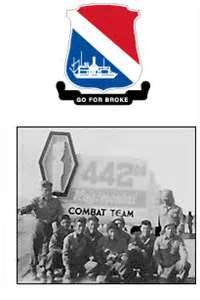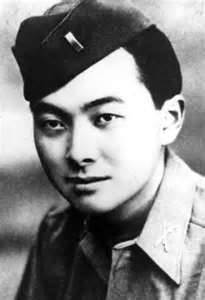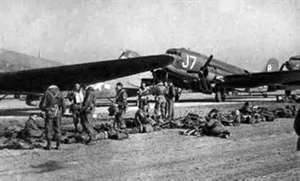The Famous 442nd: Japanese-Americans Fought Fiercely for America
The 442nd Regimental Combat Team, made up nearly entirely of Japanese-Americans, was the United States Army's most decorated infantry regiment ever. The volunteers who made up the 442nd fought in Europe in the last two years of World War II.
Members of the Hawaii Territorial Guard, which was composed mainly of ROTC students from the University of Hawaii, petitioned to be included in the war effort, and they were given permission to form the Varsity Victory Volunteers, whose involvement was restricted to military construction jobs. AT the same time, members of the 298th and the 299th regiments were formed into the Hawaiian Provisional Battalion, later called the 100th Infantry, and sent to Wisconsin for training.

The 442nd also accomplished a feat unique in the annals of the U.S. Army. On March 23, 1945, they captured a German submarine and presented it as a gift to the Navy. After dispatching their "gift," the 442nd went on to break the vaunted Gothic Line, a huge network of German gun pits and concrete-reinforced trenches that featured more than 2,000 machine guns that could provide interlocking fire. In April of that same year, the 522nd Field Artillery Battalion, one unit of the 422nd that was sent further west, entered Germany and found the outskirts of the Dachau concentration camp, from which they rescued hundreds of prisoners and gave them food and clothing. In the end, more than 14,000 served in the 442nd, the nickname of which was "Go for Broke." Between them, they were awarded 18,143 awards, including 9,485 Purple Hearts, 21 Medals of Honor, 52 Distinguished Service Crosses, 560 Silver Stars, 4,000 Bronze Stars, 22 Legion of Merit Medals, 15 Soldier's Medals, one Distinguished Service Medal, and eight Presidential Unit Citations. |
|
Social Studies for Kids
copyright 2002–2024
David White

 The U.S. Government declared martial law in Hawaii after the Japanese attack on Pearl Harbor, on Dec. 7, 1941. Sighting of Japanese submarines had been reported along the West Coast, and fears of an invasion of Alaska and further south were very real. Distrust of Japanese and Japanese-Americans was quite high in many areas of the U.S. At that time, a very large number of Hawaii residents were Japanese or Japanese-American. Although the U.S. Government authorized internment of Japanese and Japanese-Americans in the mainland U.S., that internment didn't extend to Hawaii because the economic risk of taking so many people out of the island economy was deemed too high.
The U.S. Government declared martial law in Hawaii after the Japanese attack on Pearl Harbor, on Dec. 7, 1941. Sighting of Japanese submarines had been reported along the West Coast, and fears of an invasion of Alaska and further south were very real. Distrust of Japanese and Japanese-Americans was quite high in many areas of the U.S. At that time, a very large number of Hawaii residents were Japanese or Japanese-American. Although the U.S. Government authorized internment of Japanese and Japanese-Americans in the mainland U.S., that internment didn't extend to Hawaii because the economic risk of taking so many people out of the island economy was deemed too high.  Army officials were so impressed with the 100th Infantry and with the Varsity Victory Volunteers that they approved the formation of a Japanese-American combat unit, on Feb. 1, 1943. An initial call for 1,500 volunteers from Hawaii got more than 10,000 responses. By contrast, a call for 3,000 volunteers from the mainland got only 1,200 responses. As a result, of the nearly 4,000 initial members of the 442nd, three-quarters were from Hawaii. (One was
Army officials were so impressed with the 100th Infantry and with the Varsity Victory Volunteers that they approved the formation of a Japanese-American combat unit, on Feb. 1, 1943. An initial call for 1,500 volunteers from Hawaii got more than 10,000 responses. By contrast, a call for 3,000 volunteers from the mainland got only 1,200 responses. As a result, of the nearly 4,000 initial members of the 442nd, three-quarters were from Hawaii. (One was  Members of the 442nd, which eventually included the 100th Infantry, shipped out in 1944, to fight in Europe. For the next several months, the members of the 442nd engaged in heavy fighting to liberate Italy from Axis control. One particularly hard-fought slog through the murderous Vosges Mountains resulted in the liberation of the city of Bruyeres. (A road in the city is named the Avenue of the 442nd Infantry Regiment.) The 442nd also succeeded in rescuing the "
Members of the 442nd, which eventually included the 100th Infantry, shipped out in 1944, to fight in Europe. For the next several months, the members of the 442nd engaged in heavy fighting to liberate Italy from Axis control. One particularly hard-fought slog through the murderous Vosges Mountains resulted in the liberation of the city of Bruyeres. (A road in the city is named the Avenue of the 442nd Infantry Regiment.) The 442nd also succeeded in rescuing the "
